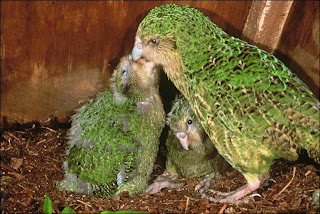True Wild Life | Kakapo | The kakapo is one of the largest species of parrot in the world with the average adult kakapo growing to around 60 cm in height. The kakapo is the heaviest species of parrot in the world and it is due to this weight that the kakapo is one of the few bird species that is unable to fly. The kakapo is native to the forests of New Zealand and the kakapo is not found in the wild anywhere else in the world. The flightless kakapo is thought to have once thrived in it's New Zealand habitat due to the fact that there were no mammals that would hunt the kakapo, and this is thought to be another reason as to why the kakapo has evolved to be a ground dwelling bird.
Like many other animal species found on New Zealand's islands, the kakapo was of great importance to the local tribes people and the kakapo appears in many local tales and folklore. The native people would hunt the kakapo for it's meat and it's feathers which the local tribesmen would use to make clothes. Due to the fact that the defenceless kakapo was hunted by the natives and the introduction of predators such as cats, stouts and rats by the European settlers, the kakapo population has been nearly wiped out with less than 150 kakapo individuals thought to have been left in the wild at the start of 2009. The kakapo is now considered to be one of the most critically endangered animal species on the planet.
The kakapo has short wings for it's large size and as it cannot fly, the kakapo mainly uses it's wings to help it balance and to support itself when hopping around in the trees. The kakapo also uses it's wings to help break it's fall when the kakapo leaps onto the ground from the lower branches of the trees. As with all other species of parrot, the kakapo has large scaly feet with two toes facing forwards and two toes facing backwards. This helps the kakapo to hold onto tree branches when the kakapo is perching on them and along with the long, sharp claws of the kakapo, assists the kakapo in climbing up trees.
The kakapo has a primarily herbivorous diet, eating seeds, nuts, fruits, berries and flowers. However, the kakapo is classed as an omnivore as the kakapo is known to eat insects and small reptiles from time to time. The kakapo is particularly fond of the fruit of the rimu tree and kakapo have been known to feed exclusively on the rimu fruit when they are in abundance. The kakapo has large brown eyes and it is because of it's large eyes that the kakapo is often referred to as the owl parrot. The shape of the kakapo's head and beak also contributes to the reason as to why the kakapo is known as the owl parrot.
During the mating season, male kakapo are often found looking for a female mate and attract one using loud calls and elaborate displays. The kakapo will only breed in years when there is a plentiful supply of food, so the kakapo reproduction process can be a slow one. Kakapo breed later on in life than most birds, with male kakapo reaching sexual maturity at around the age of 5 and female kakapo can be nearly 10 years old before they can breed. Kakapo tend to live very long lives with the average kakapo individual getting to around 60 years old. It is not uncommon however, for kakapo to get to be much older and many kakapo individuals get to be nearly 100 years old.





No comments:
Post a Comment